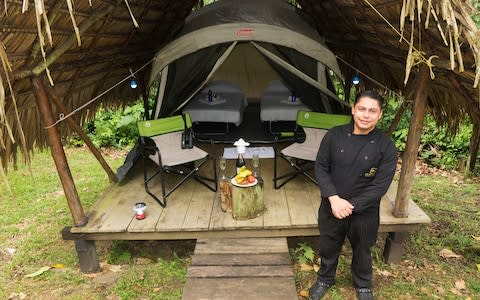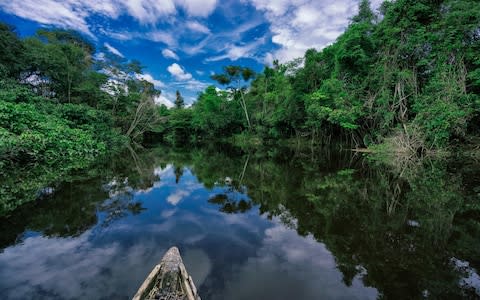Jungle glamping, the only way to hear the Amazon come alive at night

Now why am I doing this? The question crossed my mind on more than one occasion after my wife Alice and I had left the considerable comforts of Manatee Amazon Explorer – a luxurious 14-cabin river ship offering exploratory voyages on the Napo River – to spend a night in the rainforest of the Upper Amazon.
“Have fun!” cried our fellow passengers as we waved goodbye from a motorised canoe taking us close to Ecuador’s Yasuní National Park, which boasts the highest concentration of biodiversity in the world, including some 600 bird species. While those left on board could look forward to sundowners in the top-deck jacuzzi and a dinner of squid ceviche and sushi, Alice and I would be “glamping” in a primeval jungle, home to indigenous tribes that shun contact with the outside world.

We got an idea of what lay in store when, the evening before, Manatee’s guide, Avel Coquinche, took us all on a night walk. Within minutes we encountered a venomous banana spider, a tailless whip scorpion and a large tarantula. The previous day we had visited a lake full of piranhas – not the flesh-eating ones.
During our four-night voyage we would also climb a 120ft-high lookout for an amazing view of the rainforest, marvel at parrots massed on a riverside clay lick, and visit a local family to lunch on lightly roasted palm-tree worms. “Like fatty bacon,” Alice noted, as she paired this delicacy with a gourd of chicha, a tangy alcoholic drink made from fermented yuca.
The ship has definite advantages: you get to observe life on the river from your private balcony and each day brings fresh sights, whether it’s a blaze of scarlet macaws perched in kapok trees or children waiting on a sandbar at dawn for the speedboat to school. So why pay extra for a night in the jungle? “Wait till you hear it come alive at night!” another guide, Diego Garces, explained. “That’s when you know you’re really in the Amazon."

Reaching our remote campsite for two proved a major part of the fun as Avel paddled us along the Challuayacu River. The wildlife was captivating – spiky-crested hoatzins, cormorant-like anhingas, red howler monkeys. At times the channel was just a few yards wide, fringed with water lilies where herons and woodpeckers played. The water dropped so low we got stuck, prompting thoughts of The African Queen, while the effort required to set up our home for the night was reminiscent of the struggles in the Werner Herzog epic Fitzcarraldo.
Mattresses, camp beds, dining chairs, table linen, slippers – everything was paddled in by canoe in advance, along with five staff, including the ship’s chef and barman. How would they cope back on board without them?
20 incredible rivers you must explore on foot
While our fellow cruisers – from the UK, USA, Canada and Australia – were great company, the private excursion did allow us to escape the bubble of ship life and enjoy time alone. We arrived at our campsite late afternoon to be greeted with cold hand towels and chilled sparkling wine – most welcome in the heat. Our well-appointed tent sat beneath a cluster of thatched shelters, and there was a kitchen area and rudimentary toilet and shower. The Manatee team had warmed up the space with flowers, candles and other homely touches.
As night fell, it became clear that for many forest creatures the day was just beginning. “Can you hear the white-throated toucans singing?” Avel whispered as he picked out key players in a nocturnal orchestra of birds, frogs, toads and – later – owls. It made a magical backing track for our fine dinner of causa (stuffed mashed potato) followed by prawns in lime sauce.
Inevitably, the conversation turned to snakes and tales of how some locals had survived deadly bites – apparently the trick is to be either extremely drunk or to know someone who can administer a counteractive electric shock using a chainsaw or motorbike. We had a bottle of Chilean red to hand.

Sounds of nature provided the next day’s early wake-up call and, after a rather poor breakfast (improvements are promised), we set off paddling again. Alice and Avel powered ahead in a kayak, meeting a black caiman on the way, while I followed in a canoe, relishing the peace and birdsong.
It had been a privilege to spend a night listening to the heartbeat of the Amazon rainforest, with no real hardship. Tarantulas kept their distance, blue morpho butterflies danced, and the mothership was waiting for us with its bubbling hot tub...
The essentials
Cruises of three, four and seven nights are available. A six-night cruise-and-stay holiday with Steppes Travel (01285 601050; steppestravel.com), including a three-night river cruise, one night’s glamping in the jungle, two nights in Quito and flights, costs from £2,995 per person.